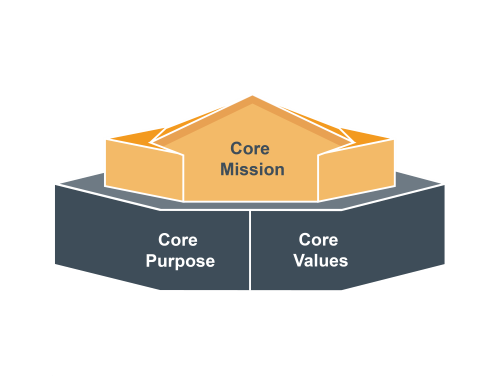What’s Your Core Mission? How to Build Employee Engagement and Resilience

The built environment has long faced a shortage of talent, and the problem is getting worse.
In FMI’s 2023 Talent Study, 93% of respondents reported difficulty in hiring qualified talent. And to meet the labor demands of 2024, the industry needs to hire an estimated 546,000 more workers. While many companies look to talent development and company branding to attract and retain talent, they often overlook a powerful and underrated lever to help mitigate the problem: establishing a clear and inspiring company mission.
As shown in Exhibit 1, adapted from Jim Collin’s “Built to Last,” a company’s core mission is one of three parts of its vision. The vision is grounded in core purpose and values, which don’t change and are often seen as reflecting the company’s brand.

On the other hand, a core mission defines where a company is going and inspires change within the organization. It represents an objective that, ideally, everyone within the company strives to achieve. It is unifying, empowering and motivating because it paints a vivid and descriptive picture of an attainable future. Note that a core mission is often longer-term and broader than a strategic plan.
The Variability of Core Missions
The core mission will look different for each organization. Some companies have more externally focused missions, such as striving to dominate their market, being recognized as the premier builder of the most prestigious projects, revolutionizing the industry or setting new standards of customer service. Other organizations focus more internally, aiming to meet specific growth milestones, transform themselves into innovative leaders or lay the groundwork for developing exceptional talent.
Whether your company’s emphasis is internal or external, establishing a clearly communicated, long-term core mission will help you align, focus and inspire your workforce.
Core Mission vs. Mission Statement
Many organizations have a mission statement — and while definitions vary, most of these offer a brief explanation of what the company does and who they serve. In contrast, a core mission is a longer-term strategic objective — think of it as the mountaintop the organization is attempting to reach. A core mission is also sometimes referred to as a BHAG (big, hairy, audacious goal) or a collective ambition.
Consider the following examples from a small regional design firm:
- Mission Statement: To provide high-quality and innovative design solutions for the built environment.
- Core Mission: To become the built environment design company of choice for clients and employees throughout the Southwest region within 10 years.
Unpacking the Power of the Core Mission
Working from a motivating core mission is key in engaging and retaining employees for three main reasons:
- It can increase employees’ sense of belonging.
- It can instill employees with purpose and accountability.
- It can drive employees’ focus and innovation.
Builds Belonging
A company’s core mission can increase employees’ sense of belonging because it has the potential to unify the workforce around a central inspiring goal. With a core mission, employees may be better able to understand how their roles and responsibilities contribute to the goal.
When people see how their career paths align with the company’s trajectory (and how that course might create more opportunities for them), they are more likely to deepen their connections with colleagues and clients. An employee might be a project manager today, but if they do the job well, they might be tomorrow’s project executive, devoting time to building more engaging client relationships. The core mission becomes part of each person’s role and responsibilities.
Drives Purpose and Accountability
Another key factor in optimizing employee resilience and loyalty is enabling employees to feel a sense of individual purpose. In fact, employees who fit a purpose-oriented profile (driven by meaning and fulfillment as opposed to money and status) are 54% more likely to stay with a company for more than five years, 30% more likely to be high performers and 69% more likely to be promoters of the company.
Without a clearly defined and understood core mission, employees may be more inclined to emphasize money and status. With an inspiring core mission that imparts purpose, we see increased engagement and focus on achievement.
Fuels Focus and Innovation
Lastly, with a motivating core mission in place, employees are more likely to be focused and innovative, because such a mission clearly defines direction and gives parameters for coming up with new solutions to problems. And yet, according to research by Prophet on innovation and resilience, 98% of leaders want their organizations to be resilient and innovative — but only 23% say they have both.
FMI’s own research shows that when employees have clarity around company purpose and values, they’re able to keep the bigger picture — the company’s vision — in perspective. Oftentimes, working actively toward a vision requires significant and innovative shifts in an organization’s operations, leadership, products and services, and market approach. So which shifts are the right ones? Without a core mission, employees may lack long-term focus and risk wasting time on innovations that are misaligned with the broader goals of the company — an area where many organizations struggle.
Chasing the shiny short-term objective often takes companies in the wrong direction, wasting valuable resources in the process. When employees know where the company is aiming to go, their in-kind efforts will be more focused.
Employee resilience is about more than just surviving; it’s about thriving. Adversity is a given, but by establishing a core mission that helps employees focus and innovate, you also help them build resilience as they learn and feel encouraged to solve their next challenge with the goal in mind.
Applying the Power of the Core Mission
If you want members of your workforce to feel a sense of belonging, purpose, accountability, focus and innovation in the interest of enhancing their loyalty and resilience, there are a few key steps you can take.
Step 1: Think Deeply About the Organization Today
Before you begin creating or revising your core mission, you must first determine where the business is. Ask yourself and other strategic leaders a few key questions:
- What are our current strengths? What are the biggest challenges holding us back right now?
- Where do we want the company to be in five to 10 years?
- What will we need to change to get there?
- What are the biggest external trends we see impacting our business over the next five years?
- How are we encouraging our pool of talent to look beyond today’s operating environment to be more strategic, long-term thinkers?
- What kind of leaders do we need to accomplish our goals over the next decade? How will their skill sets need to differ from what we have today?
Step 2: Create or Review Your Core Mission
Remember, a core mission should be clear and compelling so that every employee understands where the company is heading. It should also be audacious but achievable — something you’re confident you can achieve but that’s not a sure bet, either. Lastly, the core mission needs to speak to and be applicable to the whole organization, not just to select business units, geographies or teams.
Step 3: Apply Broadly
Once the organization has clarified a core mission, the real work begins. Every employee needs to understand the organization’s destination and what it will take to get there. Keep in mind that no company can achieve its core mission without change — and it’s change that you’ll want to make sure to clearly communicate. Furthermore, employees need to be able to grasp how they can contribute to progress.
Not only does the core mission need to be communicated clearly and frequently — it should also be applied across your company’s processes. Your core mission, as part of the broader organizational vision, should serve as a backbone for processes such as peak profiling of key roles, talent development, strategic decision making and succession planning.
When a company does the work to establish, communicate and operationalize a quality core mission, the future is bright for all. The sense of belonging, purpose and accountability among employees will reverberate throughout the organization as employees approach their work with improved focus and innovation.
So what happens when your organization achieves its core mission? You simply establish the next one. The work of business is never finished, after all, and the enduring future-focused orientation will drive your company to heights never imagined.


.png)
